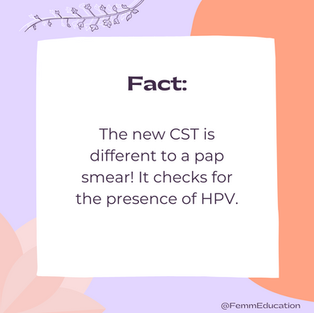Cervical Screening Test
- FemmEducation

- Jan 27, 2021
- 2 min read
PAP SMEAR? HUH? WHAT PAP SMEAR? ....
Cervical Screening is probably one of the most important screening tools we should use as women, and yet it is probably the most under-used and the most feared. Well I am here to kill that fear where it stands and help all you ladies out there feel waaaay more comfortable going in for your next cervical screening 💪🏻👊🏻
The Cervical Screening Test (CST) is the new test for cervical health and is replacing the old Pap Smear Test. The CST was developed as an earlier screening tool for cervical cancer. Where the Pap Smear Test used to check for cervical cell changes, the CST works by detecting the presence of human papillomavirus (known as HPV), a virus that commonly leads to cervical cell changes and potentially cervical cancer. Therefore, the CST is more effective in early detection and prevention of cervical cell changes and ultimately cervical cancer.
CST FACTS:
🔸 If you have ever had a Pap test before, the way the test is done will feel the same.
🔸 The Dr will use a speculum to visualize your cervix, and then use a small brush to collect a sample of cervical cells to send away for testing.
🔸 This procedure can be uncomfortable but is generally not very painful.
🔸 The CST replaces the two-yearly Pap test and should be completed every 5 years instead.
🔸 Any female aged 25 to 74 who has been sexually active should have a CST. This includes women both vaccinated and unvaccinated to HPV.
🔸 For these women, your first CST should either be two years after your last Pap Test, or immediately for those who did not have a Pap Test previously.
However, if you have symptoms at any age, such as abnormal vaginal bleeding, pain or discharge, you should discuss this with your healthcare provider as soon as possible as you may require testing. #CST#cervicalscreeningtest#cervicalscreening#papsmear#paptest#cervix#vulva#HPV#humanpapillomavirus#cancer#cancerscreening#healthcare#health#womenshealth#healtheducation#education#knowyourbody#beproactive#proactivehealth










Comments